Not to be confused with the TRS-80 game. This was “lost media” at the time I was first writing about Sharpsoft but was rescued two months ago as discovered by redhighlander. I have it packaged with an emulator at this link and the easiest way to play is to load the third save state, noting that lowercase is required and it uses DELETE instead of BACKSPACE.
Before I go on with Sharpsoft (and the history of this game in particular) I should briefly give an early history of Sharp personal computers, because it’s a bit of a mess and I need a reference as much as you do.
Sharp has been around since 1912 although not starting in electronics; the founder, Tokuji Hayakawa, got his first patent for a snap buckle. Three years later came the Ever-Sharp Pencil (and the source of the eventual name of the company Sharp).
In the 1920s the company started in radio, and has had fingers in electronics ever since. Importantly, they were involved early with calculators, including (in 1964) the first all-transistorized desk calculator from Japan, the Sharp Compet CS-10A.
By the time they got involved with personal computers in 1978, they had been making calculators for over a decade, which helps to explain the keyboard on the MZ-80K.

From the Home Computer Museum in the Netherlands.
The K stands for “kit” — this was first sold as a kit computer although it started to be sold fully assembled in 1979.
From the people who I have read who have touched a real one, the keyboard is miserable to type on and feels like what would happen if a company used to calculator keys made a transition to personal computers. (Possibly also cribbing from the Commodore PET, but that doesn’t make things better.) You’ll also notice a lack of BACKSPACE which is why DELETE is being used instead for the same function in Escape from Colditz.
Sharp also put out a blizzard of computers in a very short time, which I feel again may harken back to their calculator roots a little, going by a quick product cycle. Riffing off the MZ-80K line is the MZ-80C, MZ-80K2, MZ-80K2E, and finally the MZ-80A from 1982 (being both a “new line” and ending the 80K line).
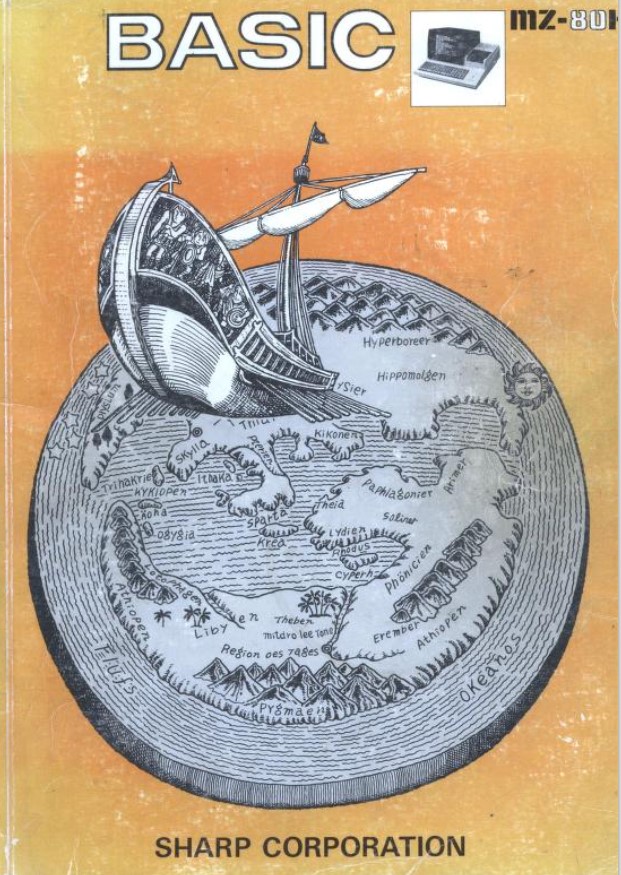
From a 1980 programming book for the MZ-80K.
There was also in 1981 a MZ-80B line offshoot that was for business computers; the Sharp X1 line (also launching in 1982, the same year as the 80A) was intended to have more powerful graphics, and was the line that eventually led to X68000, the only Sharp computer that “mainstream” retro-nerds tend to care about; it was analogously comparable to the PC-98 but more capable of handling “smooth scrolling” and arcade action.
To shorten things out…
1. first Sharp computer — 80K
2. next-gen continuation of 80K — 80A
3. business computer line – 80B
4. graphical line – X1
…with MZ-700 (that I played Secret Kingdom on) being a continuation of the 80A line, adding color.
The tape that was discovered for Escape for Colditz had copies for MZ-80K on one side and MZ-80A on the other. I played the 80K version. It must have been a later printing; the game was originally available in 1981 only for the 80K (the 80A wasn’t out yet).

Two sides of the same tape, via Sharp MZ Software Archive.
Regarding the publisher Sharpsoft, they have an ad in January 1981 Personal Computer World indicating they’d been around since 1980, although the absolute earliest they could have been founded was from the start of Sharp computers in the UK, the October 1979 launch at the Birmingham International Business Show.

We have an August 1981 contract with them via Terry Johnson for selling the software PrintPlot at £5.85.
There are many graphics utility programs but PrintPlot’s advanced features make it unique. Essentially, the program enables the user to plot a static graphics display directly on the screen using enhanced cursor facilities. Once complete, the program will automatically convert the display into a series of Print statements contained within a subroutine. When required, the program can be instructed to delete itself, leaving only the display subroutines which can be incorporated into subsequent programs.
The contract mentions 15% royalties, and proves they were contracting out rather than just cranking out all their own software. I’m guessing Colditz was picked up as another contract like the one with Dr. T. Johnson, but I don’t have an author associated (nor any names associated with Sharpsoft themselves). I will keep digging.
In the meantime, let’s break out the game! Which has us escaping from Castle Colditz (again). You can read the general historical background at that link; the shortened version is that Castle Colditz was an infamous Nazi POW camp considered “escape-proof” and a great deal of energy was put by prisoners into attempted escapes.
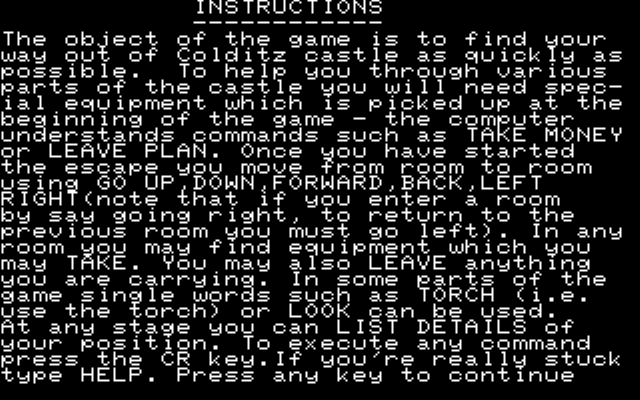
Note: LEFT, RIGHT, FORWARD, and BACK, not compass directions.
This time, oddly, we have a choice of equipment to start with. The Escape Committee consisted of POWs who did not attempt escape themselves but rather coordinated other escapes. The actual game effect is to be something akin to a gamebook (with the same unfortunate ramification of possibly softlocking the game before it even has started). You can carry a limit of four items.

I’m not 100% sure if the softlocking-on-start thing is true, because what this game is designed around is a short trek with a bunch of “alternate passages”, and some of the passages quite explicitly say what you need to pass through them. I made it through with a ROPE LADDER, a TORCH, some ANISEED (that’s for guard dogs, for some reason), and the CASTLE PLAN, which you can’t even leave the Committee room without taking.
Ideally — and I think this is what the author(s) were shooting for — you could pick any combination and find one unique route for passing through, then replay with a completely different set for a new route. In practice I don’t think it worked out, but I’ll be up-front and say my map isn’t comprehensive.
Before showing you the first part, I should mention one other unique “quality” to the game. The parser is a one-letter parser. It cuts off everything but the first letter of your command. I thought two letters was extreme, but it finally has been topped.
How does that even work for a parser, given T could be TAKE or THROW or literally any word starting with T? Well, the parser doesn’t actually do any verb-noun processing in the normal way; it takes the first letter of each word to form a combination. So GO UP gets turned into G U, GO DOWN gets turned into GD, GO FORWARD gets turned into GF, etc. which explains this part of the source code:
1010 A1$=”GUGDGFGBGLGR”:REM MOVES(6)
1011 A2$=”TMTSTLTTTITCTKTPTATRTUT1T2T3T4″
1012 REM TAKING EQUIPMENT
1013 A$=A1$+A2$+A3$
1014 A3$=”LMLSLLLTLILCLKLPLALRLUL1L2L3L4″
1015 REM LEAVING EQUIPMENT
1016 A4$=”SERHKQBHCPUALD”:REM OTHER COMMANDS
I’m not even sure what all of these things are, but LD is LOOK DETAILS (the equivalent of checking inventory plus getting a room description, although the game neglects to describe any objects sitting around in the room). KQ is KEEP QUIET, UA is USE ANISEED (fortunately this is prompted wholesale); fortunately this is prompted explicitly when it comes up.
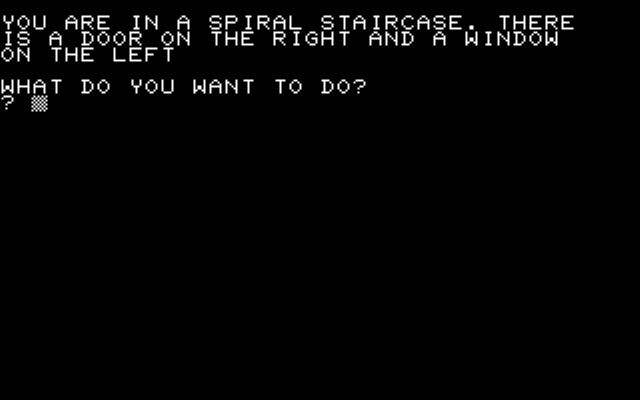
If you try to go down through the window the game states YOU DON’T KNOW HOW FAR DOWN IT IS FROM THE WINDOW; this is the very first possible alternate route where maybe there’s a way through but I don’t know what it is. The game doesn’t like to react to active use of items.
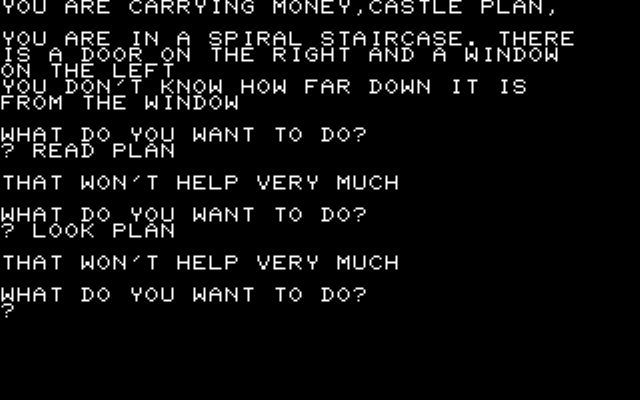
From my first run of the game, trying to treat this like a “normal” adventure game with a real parser and responsive world model and so forth. Even though you need the plan to start I don’t think it gets used during the game otherwise.
Also, if you skip by testing out the window the game will complain that you should have tried out the window. This mixed messaging stumped me for a lot longer than you might think; it took me a while to realize that any items that I was using were going to trigger between rooms (the ones I got to work, anyway) and the only other commands I ought to worry about are explicitly listed when one of the random guards comes up.

More early blundering, even though if you check the help it mentions CLIMB as a possible word. You’re just supposed to GO UP.
Here’s an example of a random guard:

Aniseed only works on dog guards, but as far as I can tell it always works. If you don’t have the appropriate defusing-object, you’ll have to resort to one of the other options which doesn’t always work.
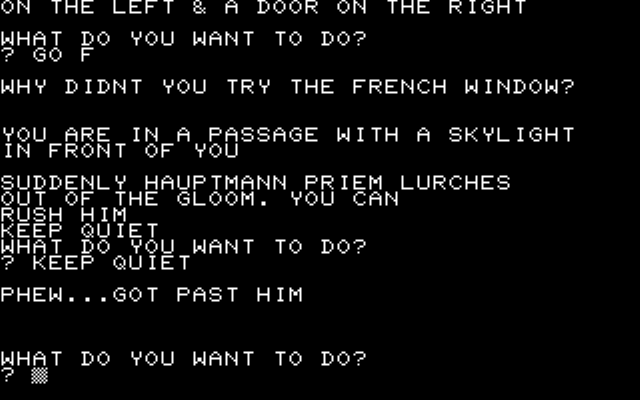
If you fail at a check, you’ll flee and drop your equipment. Usually this isn’t a problem, unless you happen to flee in a direction where you need an item to get back. (Mind you, this doesn’t always make sense, like the exit that requires a rope ladder, which you somehow can travel back through without said rope ladder.)

Because of all the parsing annoyances and general confusion the map took me a while to make, and I know this isn’t complete, but here’s my first part anyway:
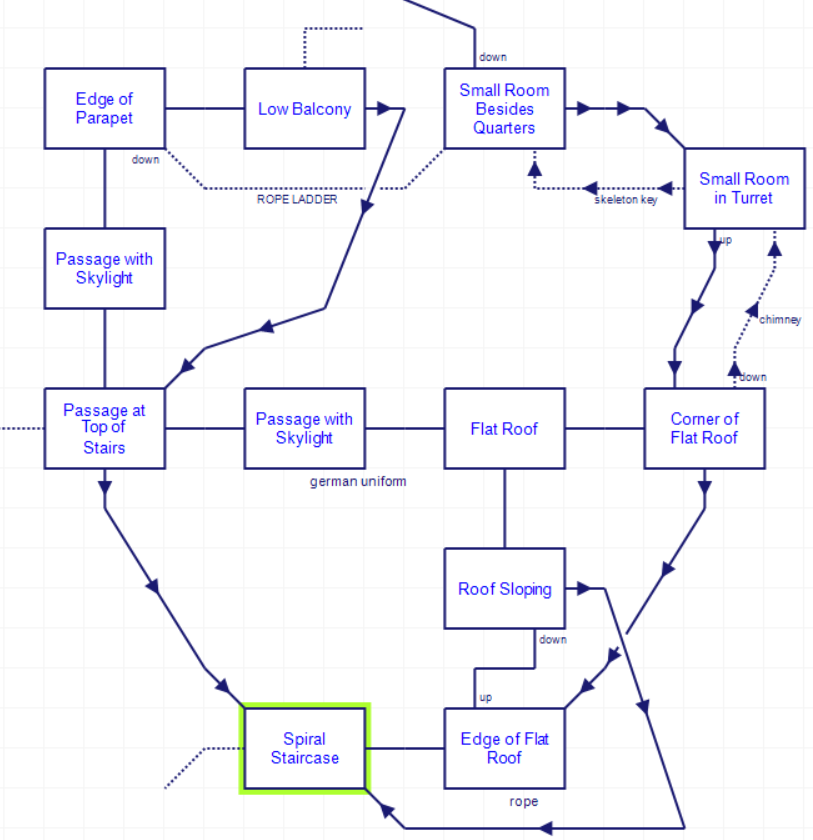
Green marks the starting room.
The “chimney” is one of those one-way confusion spots. The game says you have to go down a chimney if you GO DOWN at the “Corner of Flat Roof” but I never got anything to work. However, you can GO UP from the other side just fine.
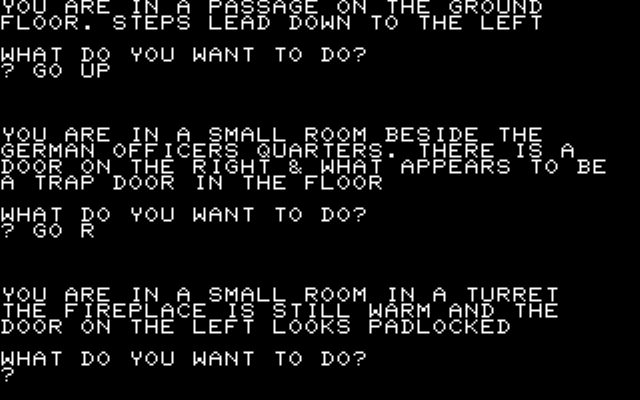
The bottom of the chimney. The door to the left requires a skeleton key to open from this side, but no key entering from the other side. This makes sense with some locks but not on a padlock.
Another alternate route was a building that looked close; any attempt to JUMP failed. I assume the game wants you to be holding a specific object, but I can’t confirm that.
My failed navigation meant the only route that worked for me was while holding the ROPE LADDER (where the game quite explicitly says you need the ladder; I didn’t have it but immediately restarted the game to pick one at the start).
Once past this I got to the second part of the map:
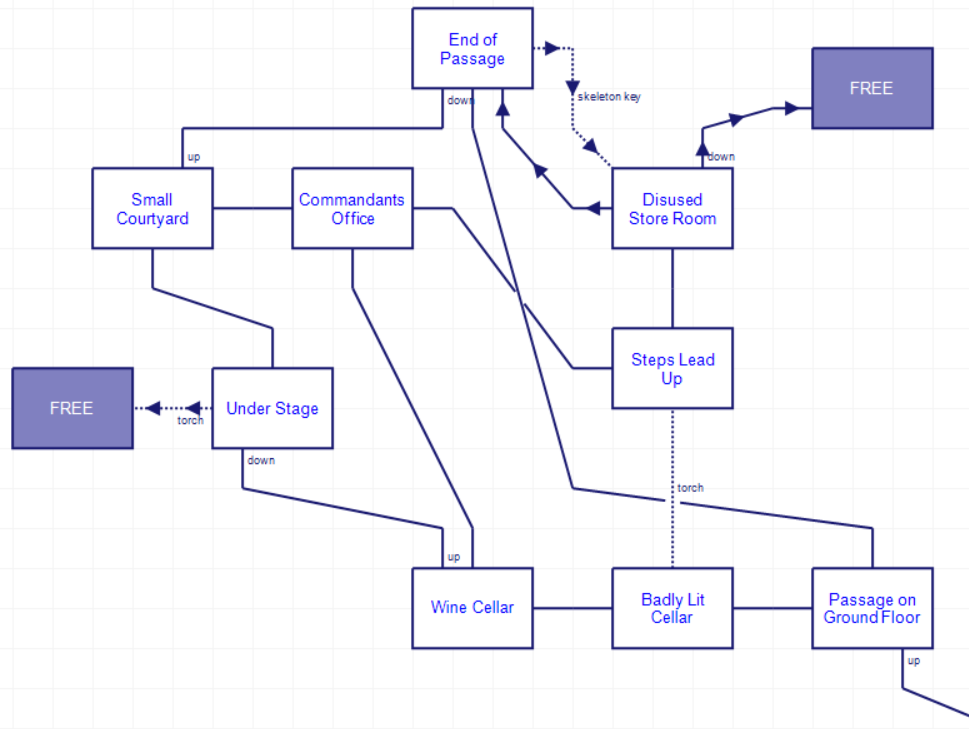
There are two passages that require a torch, which I happened to have, but there’s a route through one of the exits that doesn’t need a torch so it is purely optional.

Reaching victory gives a little bit of British patriotism music, so I’ve dropped it in video form.
The dread and envy of them all.
No, this is not a great game. It almost feels like — especially because of the parser — like someone described an adventure game to the author(s) and they tried to write one based on the description, rather than the usual familiarity with Crowther/Woods Adventure. I do appreciate their concept was interesting, even if they didn’t pull it off: adventure game more as a strategy game, with choices at the beginning affecting the gameplay overall. If this was done properly there’d be agonizing over options in a way we have enough information to make an thoughtful choice (should I get money for bribes, or the aniseed) and it truly would be possible to get through with alternate routes — but not in a way so bare-bones that only one specific item is required.
I do think the game is short enough it is fun to noodle with once you understand the limits of the parser, and maybe someone (one of you reading this, I mean) can discover a few lurking secrets. Here’s that download link again, and remember to load using the third save state. With the CPU set at x4 (from the Control menu) the speed is tolerable, although keep in mind this is a wonky late-70s keyboard so you shouldn’t try to type fast.

What Sharpsoft cases looked like at the time, via The Centre for Computing History.



Leave a comment